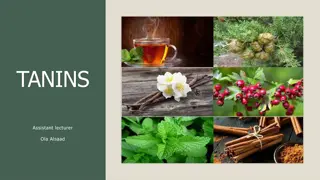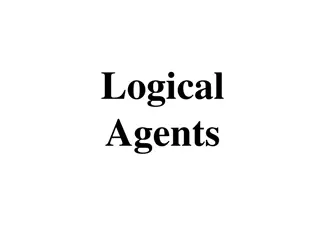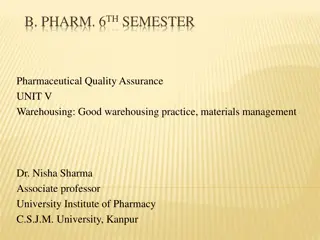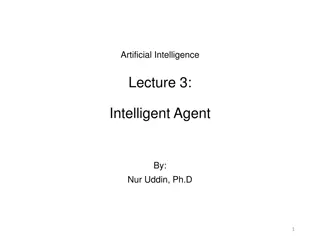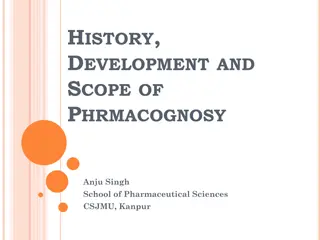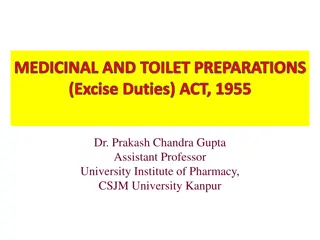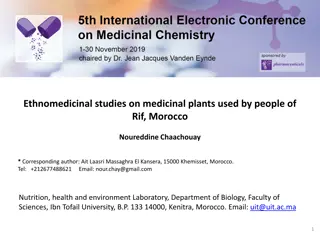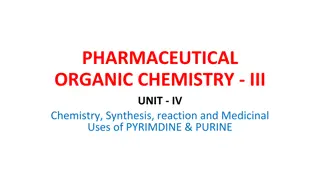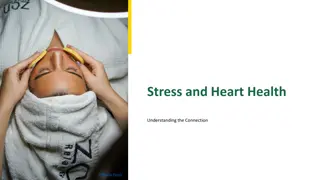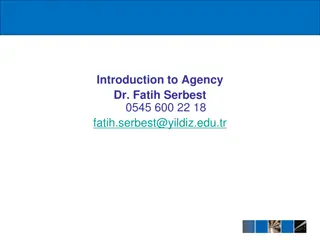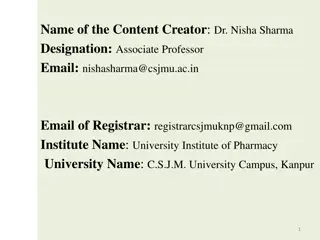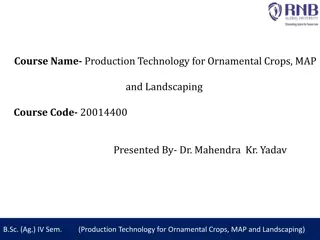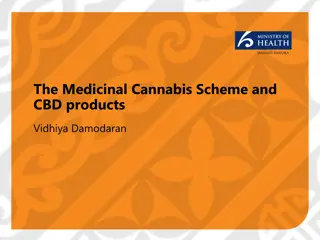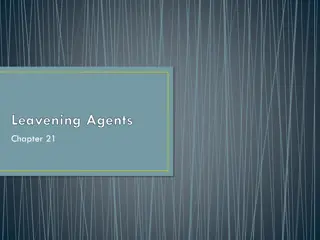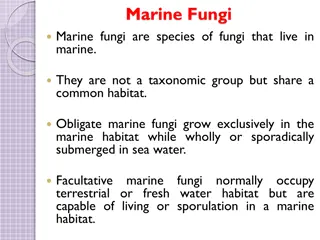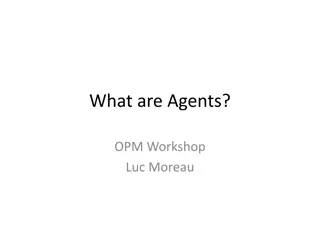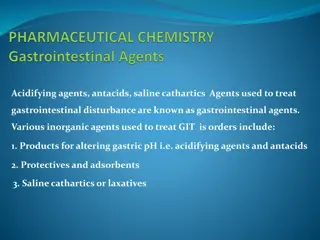Marine Novel Medicinal Agents from Marine Sources Compiled by Dr. Nisha Sharma
Oceans, covering more than 70% of the Earth's surface, harbor a plethora of invertebrates and algal species, providing a rich source of medicinal compounds. Marine organisms have yielded commonly used drugs like shark and cod-liver oils, sodium alginate, agar-agar, and chitin. Various classifications of marine compounds include antibiotic, anti-inflammatory, antimicrobial, cardiovascular active, anti-cancer, and more. Examples range from Cycloeudesmol and Ircinin-1 to Manoalide, HolotoxinABC, and Tetradotoxin, showcasing the diverse therapeutic potential of marine resources.
Download Presentation

Please find below an Image/Link to download the presentation.
The content on the website is provided AS IS for your information and personal use only. It may not be sold, licensed, or shared on other websites without obtaining consent from the author. Download presentation by click this link. If you encounter any issues during the download, it is possible that the publisher has removed the file from their server.
E N D
Presentation Transcript
MARINE Novel medicinal agents from marine sources COMPILED BY DR NISHA SHARMA
Marine drugs Oceans cover more than 70% of the earth s surface with over 200,000 invertebrates and algal species. Commonly used Drugs obtained from marine organisms which are being used are shark & cod-liver oils, sodium alginate, agar-agar, and chitin etc. Classification Class Examples Antibiotic compunds Cycloeudesmol, variabilin, Ircinin-1 Anti inflammatory & anti spasmodic Manoalide, Tetrado toxin Antimicrobial compd HolotoxinABC, Tholepin, eunicin acanthelin Cardiovascular active compd Anthopleurins, Laminine, Eptatretin, saxitoxin, spongosine, eledosin, ATX-II, Autonomium Ara-c, crassin acetate simularin. Anti cancer (cytotoxic) Marine toxins compds Ciguatoxin, Palytoxin, Saxitoxin, Brevetoxin Miscellaneous compd Kainic acid, Domoic acid, Aplysinopsin.
ANTIBIOTICS COMPOUNDS Organism Antibiotic Substance Marine bacterium, Pseudomonas bromutilis 2, 4 - Dibromo - 6 - (3, 4, 5 tribromopyrrole - 2 - yl) phenol Cycloeudesmol Variabilin, Ircinin 1 Red algae, Chondria oppositiclada Sponge, Ircinia strobilina and Ircinia oros Sponge, Verongia archery 3, 5 - dibromo - 4 - hydroxy benzene-1 acetamide
ANTI INFLAMMATORY COMPOUNDS Organism Anti inflammatory Substance Manoalide (analgesic also) MOA/ uses Luffariella variabilis (sponge) it acts by direct inactivation of phospholipaseA2enzyme present in some neurotoxins and also has a role in synthesis of prostaglandins Antiinflammatroy Phyllospongia dendyi; sponge dendalone 3hydroxy butyrate flexibilide soft coral, Sinularia flexibilis Brown algae, Caulocystis cephalornithos. Flustra foliaceae, a Swedish marine moss. liver and ovaries of puffer fishes 6-n-tridecyl salicylic acid Flustramine A& B Muscle relaxant Tetradotoxin strong antispasmodic.
ANTI MICROBIAL COMPOUNDS Organism Sea cucumber, Stichopus japonicus ANTIMICROBIAL HolotoxinA, B and C (steroida glycoside) antifungal in nature Zonarol and iso-zonarol Brown algae, Dictyopteris zonaroides Red algae, Bonnemaisonia hemifera Tetrabromoheptanone Four isomers of polyhalo 3 butene - 2 - one and seven isomers of polythaloacetones. Aeroplysinin-1 (+) Aeroplysinin-1 (-) 2 - cyano - 4, 5 dibromo pyrrole Prepacifenol Red algae, Asparogopsis taxiformis. Sponge, Verongia aerophoba Sponge, Agelas oroides Red algae, Laurencia pacifica and L. filformis. Annelida, Thelepsus setosus Sea hare, Aplysia californica Gorgonian corals, Eunicia mammosa Acanthella acuta Tholpin Debromolaurenterol Eunicin Acanthelin -1 (active against Mycobacterium)
CARDIOVASCULAR ACTIVE SUBSTANCES Organism peptides obtained from coelenterates Anthropleura xanthogrammica A. elegantissima aneural bronchial hearts of pacific hogfish viz. Eptatretus stoutii. marine algae, Laminaria angustata Octopus macropus, O. vulgaris and Eledone moschata Saxidomus giganteus, and California mussel, Mytilus californianus. sea anemones Sea cucumbers, Holothuroidae family Compounds Anthopleurins: (AP -A and AP - B); type C (AP C) Eptatretin Laminine D ( ) Octopamine Saxitoxin ATX II (POLYPEPTIDE) Holothurins (triterpenoids moiety) star fishes of family Asteroidae Caribbean sponge Crypotethia crypta. posterior salivary glands of cephalopod Eledone moschata. asterosaponins (steroidal aglycone) Spongosine (nucleoside) Eledosin
ANTICANCER SUBSTANCES Compounds Caribbean sponges: spongosine and spongouridine. Organism Ara C: 1 - - D - arabinofuranosyl cytosine or cytosine arabinoside. Used in acute myelogenous leukemia and human acute leukemia, Crassin acetate cyclic diterpene human leukemic and HeLa cells in-vitro. simularin, dihydrosimularin and simulariolide. Asperdiol geranyl hydroquinone (cytotoxic to leukemia and mammary carcinoma) aplysistatin (antileukemic) halitoxin (antitumour) majusculamine - C (inhibitor of X - 5563 myeloma) Caribbean gorgonian, Pseudoplexaura porosa (soft corals) Soft coral Sinularia flexibilis Gorgonian coral Aplidium species Sea hare Aplysia angasi Sponge Haliclona viridis; Algae Lyngbya majuscula; Sea sqirt Ecteinascidia turbinata.
MARINE TOXINS Compounds Organism Effects Gonyaulax catenella G. tamarensis saxitoxin depolarises membranes, permeability alteration to Na+ Haliclona rubens Gambier discus toxicus Palythoa species Lophogorgia rigida holotoxin maitotoxin potent neuromuscular blocker stimulates calcium channels in insect skeletal muscles most potent coronary vasoconstrictor neuromuscular blocker palytoxin lophotoxin Ptychodiscus brews Gambier discus toxicus Babylonia japonica brevetoxin ciguatoxin positive inotropic and arrhythmogenic respiratory depression and bradycardia neosurugatoxin potent blocker of sympathetic ganglia and a specific blocker of nicotinic Ach receptors
MISCELLLANEOUS COMPOUNDS Organism Compounds Effects red algae: Digenea simplex Kainic acid potent convulsant, antiascariatic activity. red algae Chondria armata marine annelid, Lumbriconeris heteropoda Sponge domoic acid activity against ascaris and pinworm. nereistoxin insecticide due to its ganglion blocking effects DidemninsA, B and C Ara -Aadenine arabinoside aplysinopsin against Herpes simplex type-2 virus in mice Herpes encephalitis. Sponge yellow sponge, Verongia spengeli antidepressant action in animals, cytotoxic activity. Eucheuma, Chondrus and Gigartina carrageenan anticoagulant agent.


